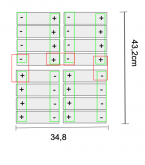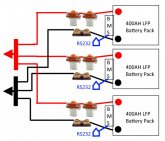Hi Rocco!
I'm also building a LiFePO4 battery that will function with a Victron setup (EasySolar). From my research it seems that the only batteries and BMS that can fully communicate with Victron equipment out of the box are listed on
this webpage (it seems to only be batteries though). As far as I understand, CANbus is just a protocol that says
how the devices should talk to each other, but it doesn't specify
what they're talking about. Therefore, the fact that the TinyBMS features CANbus communication is not sufficient to ensure that it can communicate with Victron devices. For that, both companies would have to coordinate their interfaces. I actually emailed the manufacturer of TinyBMS to ask whether they support Victron devices over CANbus but they told me they didn't ("Our CAN UART converter is capable of minimalistic command transmission. Currently, we do now know how it will operate with your specific equipment.")
However, Victron provides another way to synchronize with any thrid-party BMS: see
here. Basically the BMS has to output 2 signals to say whether charge/discharge are allowed and they come as inputs on your Victron inverter (better to isolate the signals with intermediate optocouplers though). The inverter will do what the BMS commands. That's great if you only have AC loads, and that nothing else draws on your battery. If you have also DC loads, then you can add a relay that will be closed only when the "discharge allowed" signal from your BMS is up.
You could potentially wire any BMS to you Victron this way, but you won't have all the details displayed in your Victron frontend. So if you also want data such as precise SOC and temperatures, you can always add a BMV-712 that will interface nicely with your devices. Depends also on what you already have.
EDIT: Ok now I see a problem coming if your really want to go with two BMS: you won't be able to have 2*2 charge/discharge signal inputs on your Multiplus.






